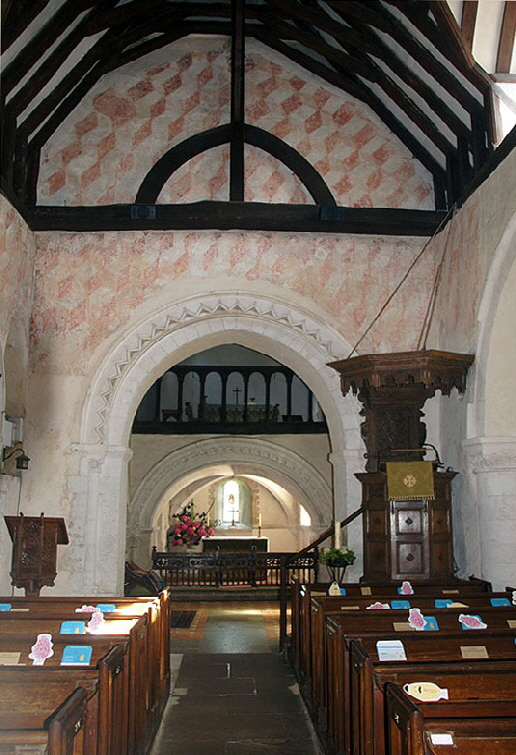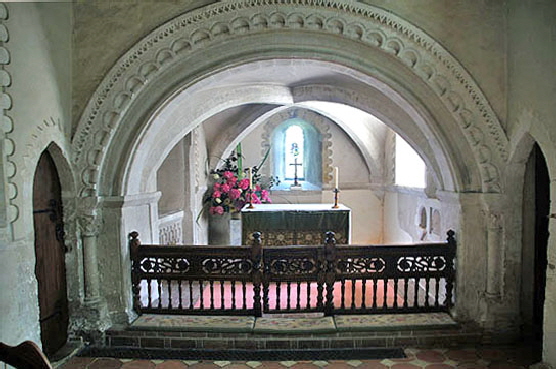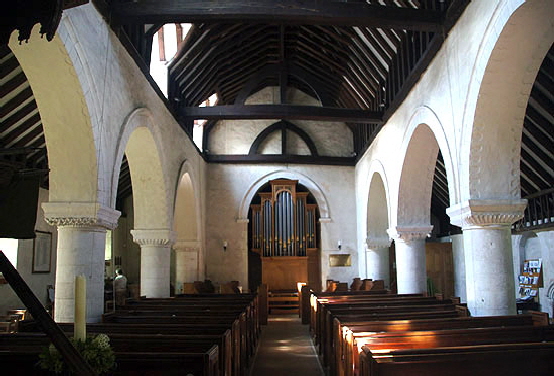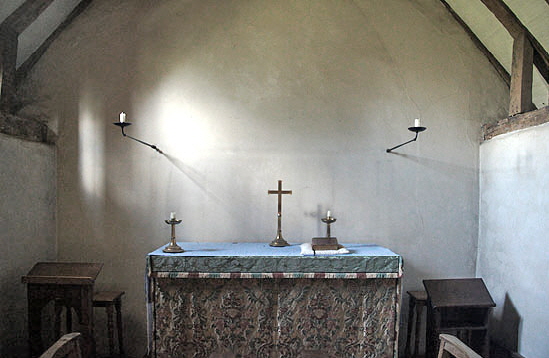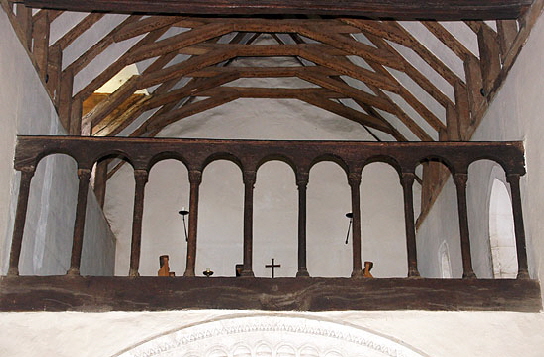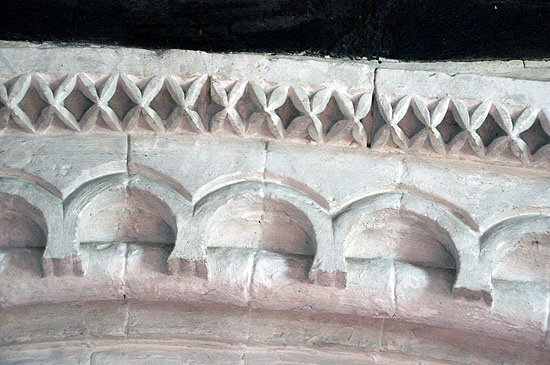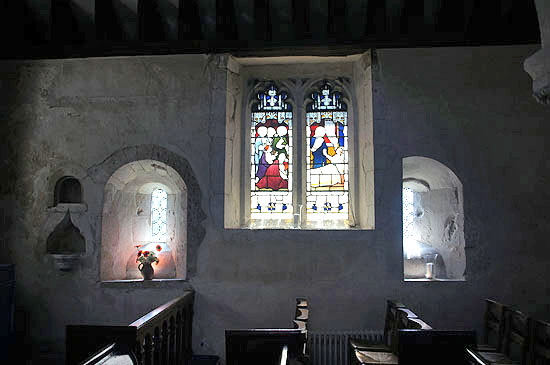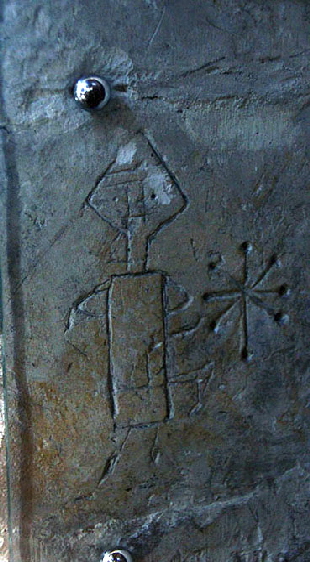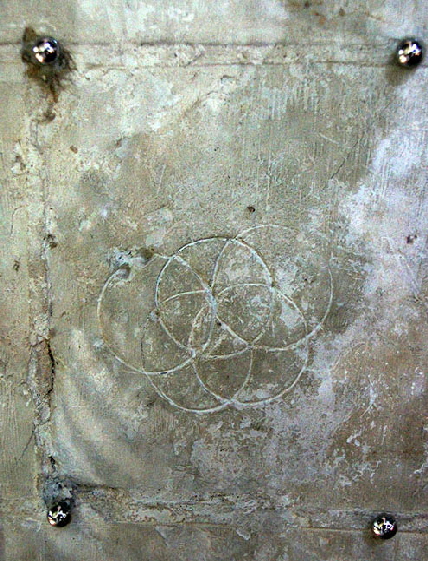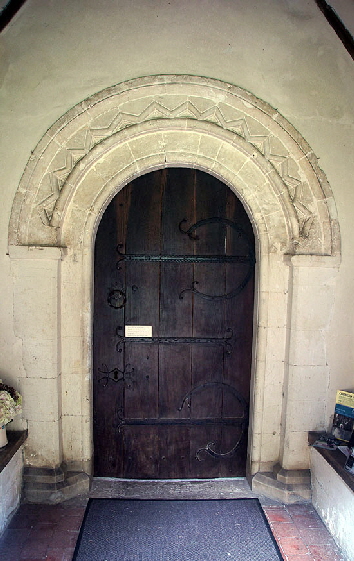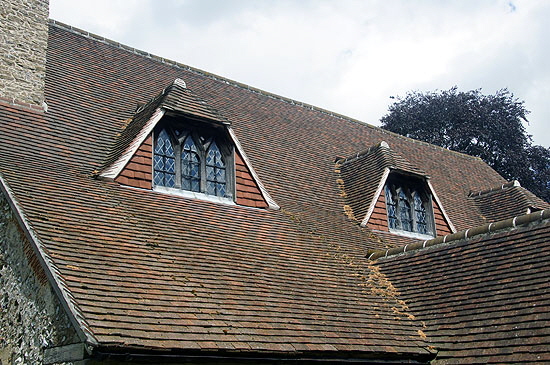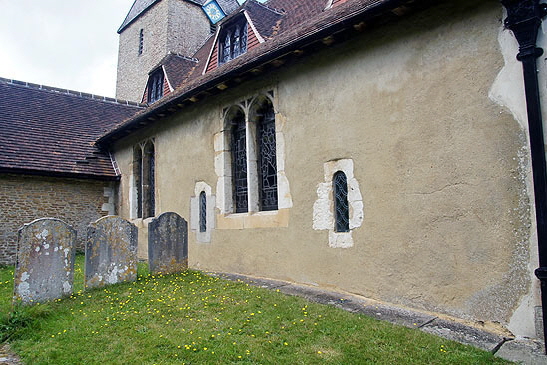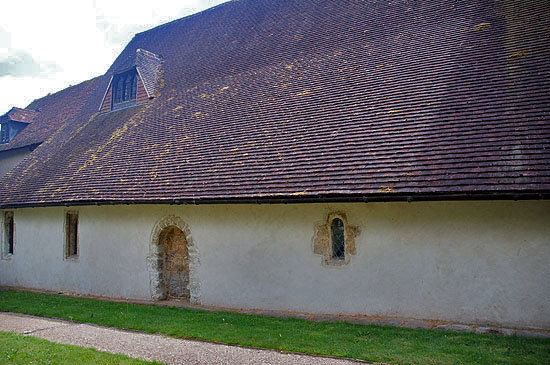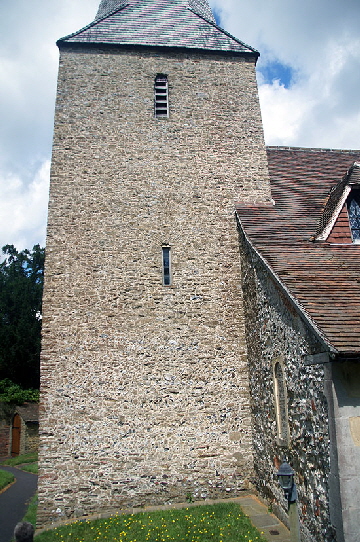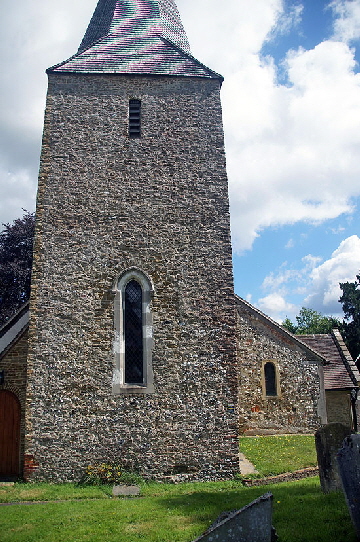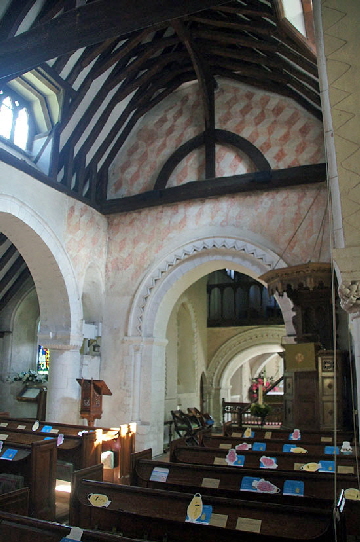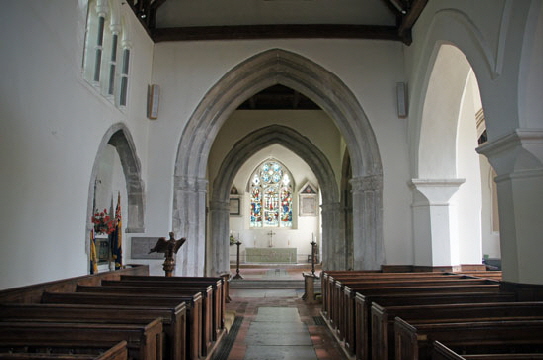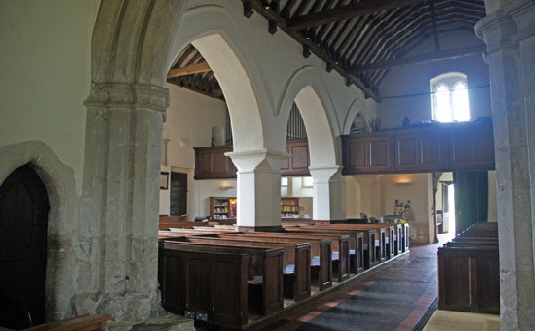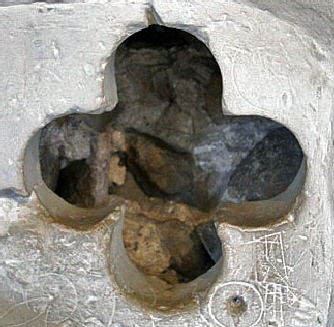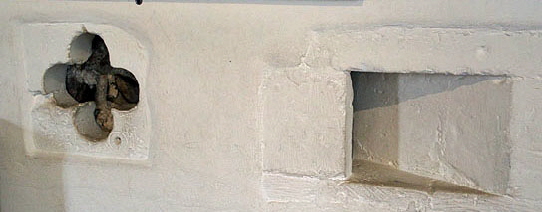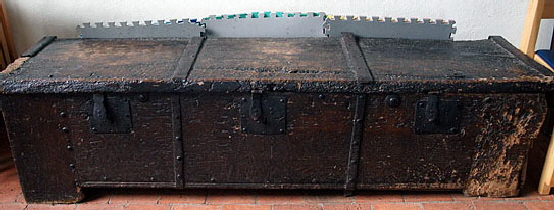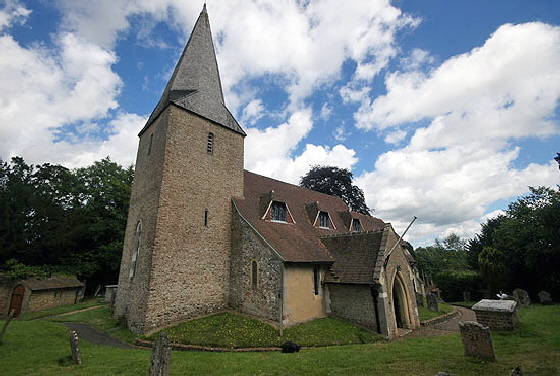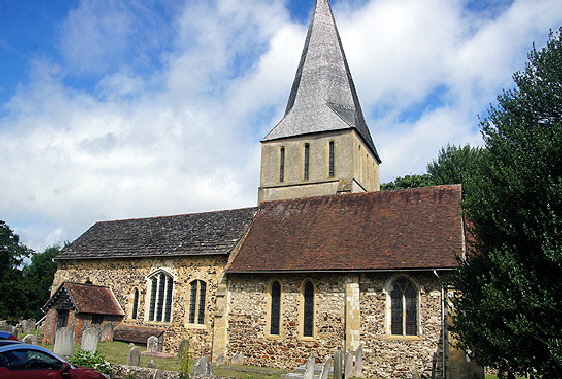 |
|
Alphabetical List
|
 |
|
County List and Topics
|
|
|
|
 |
 |
|
It’s always a pleasure to write about a church in a county I haven’t touched on before. In the case of prosperous and beautiful Surrey this might be a bit of a surprise but to quote Simon Jenkins (so don’t shoot me!) “Poor Surrey. It must have the least exciting history of any English county, and its churches agree”, Ouch! Simon goes on to compound the sin by awarding the wonderful Compton Church a niggardly two stars.
The picture on the left is taken with a very wide angle lens. It’s not really the “Crooked House” that it appears here! Underneath those rather engaging dormer windows that constitute its clerestory this church houses a great treasure: a Norman double decker chancel, both parts of which are still in use.
To enter this church through its south door and then to look to your right is to be presented with on the most visually stunning eastward views of all of the parish churches in England. You see the tall Norman chancel arch surrounded by mediaeval painting and beyond it the squat Norman sanctuary arch. Above that is the original wooden rail to the upper chancel. It is a view unique in England. Darenth in Kent and Tickencote in Rutland both have upper rooms to their Norman chancels but they are invisible within and there is no evidence that they ever were used as second chancels.
In the base of the tower in particular, there are indications of a pre-Conquest
|
|
 |
 |
|
church. That’s a little bit academic, however, in a church that is so fundamentally Norman in origin. Externally it’s a muddle that belies the joys within. Rendered walls sit uneasily alongside original stone facings. I find the tiled nave roof utterly charming and its dormers vaguely continental. Others might feel that someone got in the local builder to do a loft extension! The seasoned church crawler, however, will quickly spot the original Norman windows scattered around the lower levels of the nave walls.
Domesday Book records a church here in 1086. The Church Guide is definitive in its statement that there was a pre-Conquest church comprising today’s tower and nave. Taylor & Taylor’s painstaking “Anglo-Saxon Architecture” (Cambridge 1965) is less sure, suggesting it may have been Saxo-Norman (ie transitional) but nobody can be sure and it is quite academic after all. There were two phases of Norman development. The first between 1080-1100 saw the chancel arch constructed with the and the extension of the old chancel which presumably took up part of today’s nave into what we see today. The windows in the chancel are all surrounded by a simple zig zag decoration that is very unusual for an interior. Between 1160 and 1180 the aisles were constructed with their hefty and characteristic Norman round-headed arcades cut through the nave walls. The arcades are remarkably plain. The asiles have never been extended outwards and so retain their original Norman narrowness. The two storey sanctuary with its balustrade was also constructed during this period. Doorways were added to the north and south. The former is, is usual north door fashion, filled in. The south door is, like the arcades, very simple. In its single course of very regular zig zag decoration and its roll mouldings this door has a Transitional look about it.
The upper sanctuary is reached by a stairway built into the south wall. At the bottom of the stairwell is a space that is believed to have been used as an anchorite cell (or “anchorhold”). Anchorites required episcopal approval for their immuration and there is no record of this having been granted which casts slight doubt on its provenance. There is, however, a wooden “prayer desk” with an area rubbed down by leaning elbows and black marks from candles. There is also a quatrefoil/cruciform opening through which sacraments may have been given. It has been said that it was occupied from “1185 to the early fourteenth century”. I don’t know on what evidence this is asserted and it suggests a succession of at least three or four anchorites which must be open to question. Moreover its coincidence with the final phase of Norman building work suggests that this, the smallest known anchorhold, was almost purpose-built rather than, as it appears, the use of a tiny space left at the foot of the stairs. There is a blocked doorway to the outside which is clearly later than the tiny Norman window alongside it. This implies the possibility of a wooden structure that would have made the anchorite’s life less claustrophobic. Just to add to the confusion, there was also a probably anchorite cell on the north side. I discuss all this complexity in my footnote below.
The upper sanctuary itself contains just an altar and a piscina. You can see on the outside a pointed drip mould. This is a remnant of a large window that was put here in 1859 but which was blocked in 1953. The only surviving east window is a tiny Norman splayed window in the lower sanctuary. One of the most visually startling features of the church is to see the low aisles with their tiny Norman windows surmounted by the massive tiled and dormered roof above it. It is to the great credit of the various restorers and rebuilders that the temptation to homogenise the structure inot some “modern” style was resisted Although my wide angle photographs distort the perspective of the church there is no faking the descent of the church towards its east end. In so many ways you really couldn’t “invent” this church and it is quite unmissable. So don’t! Even if it is in “Poor Surrey”.
|
 |
 |
|
Left: The upper sanctuary. Some suggest it housed relics; some that it was a gallery; others that it was for anchorite use (reinforcing the implausible idea that the church catered for anchorites by design). Nobody knows. Right: The oldest wooden balustrade in England protects the upper sanctuary.
|
 |
 |
|
Left: Segment of the sanctuary arch. Note the regularity of the four-leafed design. This was a skilful mason at work. Right: The east end of the south aisle. Note the deeply splayed tiny Norman windows. Incongruous as it looks, you can understand why the rectangular window was required later in the life of the church. The aumbry is Norman and the piscina below it fourteenth century. There was clearly an altar here.
|
 |
|
 |
 |
 |
 |
 |
 |
 |
 |
 |
 |
 |
 |
 |
|
 |
 |
 |
 |
 |
|
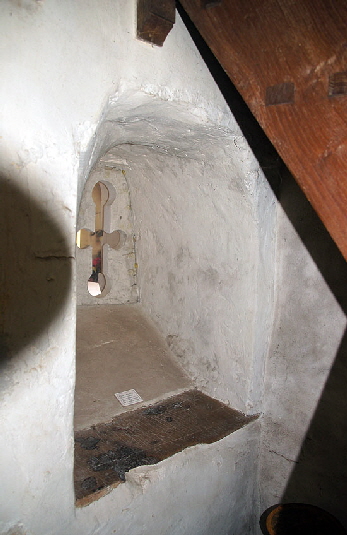 |
|
|
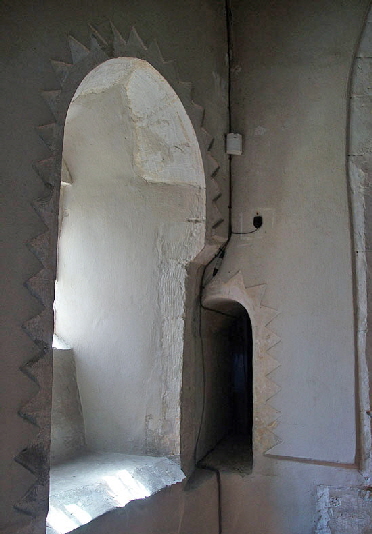 |
|
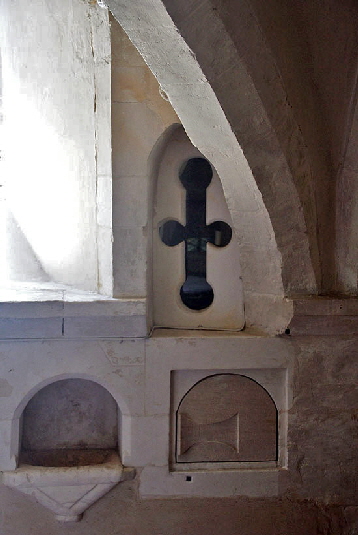 |
|
|
|
|
|
|
Left: An interesting, possibly unique, composition on the south side of the chancel. The Norman window is adjacent to a squint through from the nave. This is the earliest squint I have seen and I have also never seen one with decoration. All of the chancel openings have this zig zag pattern. The electrical outlet is modern and you can tell this by the lack of zig zag decoration...Centre: Above the piscina - itself a superb Norman example - and the aumbry on the south side of the sanctuary is the cross-shaped anchorite’s squint. Right: The squint from the inside of the wall with the stairway to the upper chancel above it. You get a flavour of just how tiny this space is. Could it really have been designed for anchorite use? Surely it is more plausible that it was adopted for this purpose subsequently, with or without the addition of a wooden “extension” to the south?
|
|
|
|
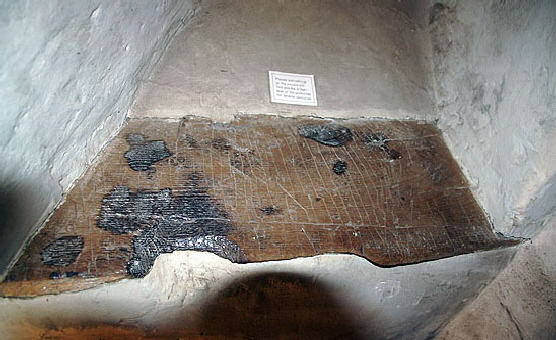 |
|
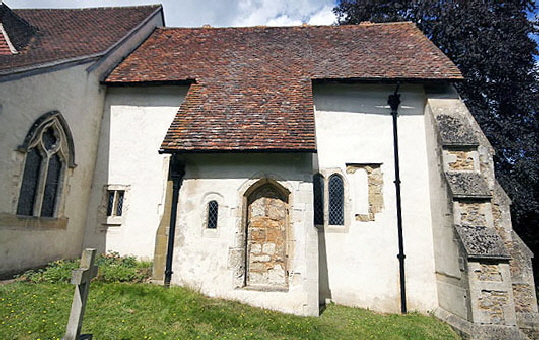 |
|
|
|
Left: The original wooden prayer desk within the supposed anchorite cell. You can see singe marks from candles and where repeated rubbing from left elbows has caused an indentation. Whether you believe that this is a relic of anchorites or of chantry priests (see footnote below) this is one of the more moving artefacts in England’s parish churches, demonstrating a piety beyond the imagination of most of us in the modern world. Right: The south cell from the outside, showing a tiny Norman window and the mysterious filled-in door (see footnote). Note a blocked Norman window to the lower sanctuary and the steep falling away of the land from east to west.
|
|
|
|
 |
|
 |
|
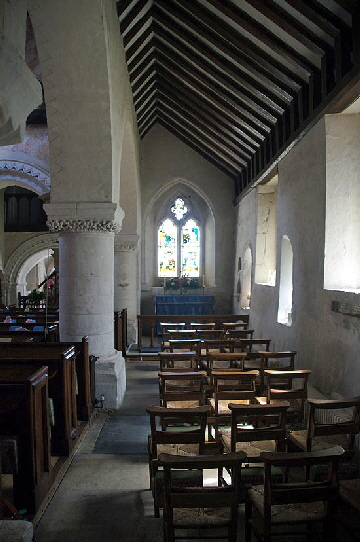 |
|
|
|
|
|
|
Left: The piscina on the south side of the upper sanctuary. Centre: We can see here that the insertion of a rood loft hard up against the chancel arch involved the hacking away of some of the easternmost arch of the north arcade. One or two of of the original steps can still be seen on the far side out of shot. The church has had to use the left by the removal of the screen to add reinforcement - a testament to the uneven ground outside! The removal of mediaeval screens is, I suppose, in the round, A BAD THING. This one, however, would have been hard up against the chancel arch and will have ruined the church aesthetically. Right: The Norman south aisle, looking east. The outer wall was raised in the late mediaeval period as the Gothic window attests. There was no extension southwards, however, so the original Norman windows were preserved.
|
|
|
|
 |
|
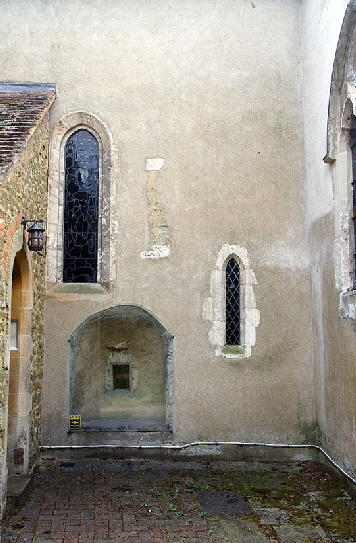 |
|
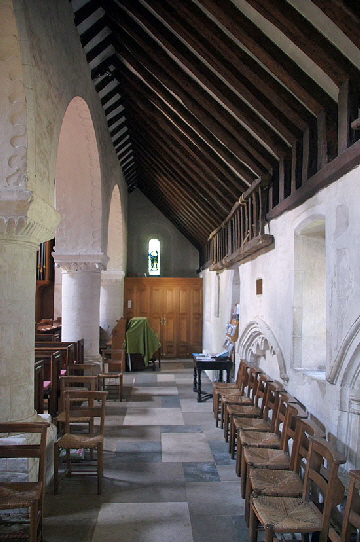 |
|
|
|
|
 |
 |
|
Left: The north aisle loking west. Centre: The Norman font dates from the later period of Norman building and is made from Carstone from the nearby “Hog’s Back” formation. Right: The site of a probable anchorite cell on the north side of the church. The blocked squint looks across the chancel and towards the north east of the lower sanctuary.
|
 |
 |
|
Left: This is reckoned to be a graffito of a Norman knight. Centre: Another graffito created by a mason’s compasses. Right: The south door in late Norman/Transitional style.
|
 |
 |
|
Left: The church from the south west. The need for the buttressing is obvious although it is aesthetically deplorable! Note the outline of the drip mould for the former Victorian east window. Only the tiny Norman lower sanctuary window remains. The rendering on the walls is another aesthetic disaster especially as it sits uneasily next to bare rubble wall. Yet somehow this church manages to carry it off! Right: Some might see the shingled roof and dormer windows as another disaster but I find them quite charming and very much in the vernacular style of this area.
|
 |
 |
|
Left: The wall of the south aisle with its Norman windows strangely dwarfed by the later Gothic ones. A bit of tarting-up wouldn’t go amiss, would it? Right: Because the walls of the north aisle have not been raised beyond the Norman level we get this rather odd composition of what looks like an aisle designed for pygmies surmounted by acres of shingles! Note the blocked Norman morth door.
|
 |
 |
|
Left: The south side of the tower. Centre: The tower from the west. The base at least was probably part of an earlier church. Right: A view from the south aisle diagonally across to the north east of the church. The roof timbers are part of the unique character of this splendid church. Note on the right zig zag decoration on the soffit of the arch, mirroring the design in sanctuary and chancel.
|
 |
 |
|
Footnote - The Compton Anchorite Controversy
|
 |
 |
|
I have come across few topics as perplexing as that of the supposed anchorite cell - or cells - of Compton Church. At Compton there seems to be differences of opinion over whether there were anchorites at all and, if there were, whether the cell was on the north or south side of the church or both.
Let's begin with the issue of whether there were anchorites here at all. The Church Guide itself says unequivocally "There is, however, no documentary evidence for the presence of an anchorite at Compton". Yet it is widely believed that there were! Simon Jenkins says so (on the south side) in his book. Mari Hughes-Edwards who wrote "Reading Mediaeval Anchorism" in 2012 quotes Compton's as being amongst the two smallest "anchorholds". Mari drew on books of 1914 and 1985 by Rotha Mary Clay and, especially, Ann K Warren respectively and maintains that there were anchorites here between 1185 and the early fourteenth century. She mentions both possible anchorhold sites at Compton and is very clear in her belief that the celebrated south room was indeed an anchorite cell. She goes as far as to suggest, as have others, that the upper sanctuary was in some way part of the anchorite's milieu.
Mari herself is enlightening in pointing out that extremes of physical privation and isolation were not necessarily required of anchorites, yet Compton's supposed southern cell has a floor space of only 2.4 square metres! You don't get much more extreme than that. Moreover, I find it quite a coincidence that Compton allegedly acquired an anchorite at more or less the time that the second phase of Norman building was completed. The space occupied by the cell is no more than the space beneath the stairway to the upper sanctuary. That is, it was surely available coincidentally and not by design. If Compton had a space for an anchorite by design then it seems to me that the upper sanctuary must have been for her use with the little cell being used by her only during mass. I can't believe that the cell under the stairs alone was planned accommodation even for an anchorite. There is a piscina there in the upper sanctuary, however. That implies the upper sanctuary was for liturgical use.
That's not the end of the debate, however. The cell has a later filled-in door to the outside. Why would that be? Access to the cell from the inside of the church is simple enough. You just go through a door in the chancel. A door from the outside then suggests the possibility of an outer building that has since been lost. If there was an anchorite cell might it have comprised both the sub-stairway area and a now-lost wooden room accessed by the new doorway? Does that imply that the function of the upper sanctuary was thereby changed as well? Or was the notion that anchorites lived here as early as 1185 fanciful?
The Church Guide notes that on the left jamb of the cell's squint there is an inscription that suggests the existence of a chantry for Henry de Guildford who died in 1311. It is also pointed out that the squint has a view to an unidentified tomb in the north of the lower sanctuary. Six skeletons were found one on top of the other beneath (not within) this tomb and this has led to speculation that they were the bones of dead anchorites. I wonder if the tomb is that of Henry of Guildford and that his death saw a change of use of the cell to a chantry? Or was a chantry its first use and there never were anchorites in this space?
All these questions and no answers.
The plot thickens considerably, however, when you take into account the further possibility of a cell on the north side. There we have another squint, this time on the outside wall and a recess that is supposed to be another remnant of a cell. Mari Hughes-Edwards herself asserts that most anchorite cells were on the "inhospitable" north side (as is the undisputed anchorite cell at nearby Shere) and sometimes on the west side for female anchorites (as at Ryhall in Rutland). The squint here looks into the chancel rather than into the sanctuary.
What can one make of all this? No single theory seems to satisfy all of the variables here. Looking at the balance of probability, I tend to believe that there was an anchorite cell on the north side. I can't see any killer argument either way for the cell on the south side but I believe it was not occupied as early as 1185. It seems to me to be more likely that it was pressed into service for an anchorite somewhat later in conjunction with the construction of a timber extension. Then when Henry of Guildford endowed a chantry for himself a new cell was built on the north side.
That seems to me to fit fairly well but I'm probably completely wrong!
|
|
|
 |
 |
|
Shere is only nine miles from Compton. You might well have never heard of it but when I visited on a Sunday I found out that a great many people have. It was packed with visitors and coach parties crowding the numerous olde tea shoppes and inns. It’s a quintessentially pretty Surrey village, full of thatch and black timbers. It is a honey pot for people seeking a pleasant family day out.
The church is not without architectural interest. It was built on the site of a pre-Conquest church. It was finished by AD1190 and is an interesting mixture of late Norman, Transitional and Early English styles. One of the crossing arches even has circular and pointed arches springing from the same base. You get the impression that the masons here were a bit bewildered by all the new-fangled styles that there were to choose from at this time!
The south door is Norman but I was unable to access the south porch, today’s entrance being from the west. The plan was slightly unusual. A tower and crossing divides nave and chancel but the church also has a south aisle, giving it a rather lopsided look. In due course this aisle was extended eastwards to accommodate the Bray Chancel dedicated to the local Lords of the Manor. The chancel has also been extended. St Nicholas Chapel on the north side of the crossing dates from the late fourteenth century.
|
|
 |
 |
|
Of particular interest is the original west door that dates from the thirteenth century. There is also a “Crusader Chest” dating from around the same time and used to store gifts donated to support the Crusades.
What sets Shere apart, however, is that it not only has traces of an anchorite cell but that the documents pertaining to the immuration of Christine Carpenter in 1329 still exist and you can see facsimiles in the church. Of the cell itself, only the squint and quatrefoil sacraments slot remain. The anchorite space at Compton is much more dramatic and moving but there is no concrete evidence that this was the purpose for which it was used. At Shere there is no doubt whatsoever. What is more, there is also documentation pertaining to her having left the cell in 1332 and her subsequent return.
The documents are fascinating for the insights they give into the church’s attitudes towards anchorites and towards spirituality in general. John, Bishop of Winchester gave his permission so this anchoritism was not something taken lightly. He talks of “the Tempter” as a real force of evil in the world. It is not difficult to read between the lines with their references to “chastity” and “virtue” that Christine was known to be a virgin and it is clear that her remaining so was one of the main spiritual benefits to be derived from her withdrawal. The Church had a very ambivalent attitude to sex, tolerating it but still believing it to be at heart sinful. Marriage was now accepted to be essential for procreational purposes but chastity and even widowhood were reckoned to be higher conditions than marriage. It was not the sex that got to the Church: it was that the damned people insisted on lusting for it and enjoying it. Which is what the whole Adam & Eve “thing” was all about.
A letter from a representative of the Pope (then based in Avignon) to Bishop John lifts from the wretched Christine the customary and dreaded punishment of excommunication. It is hard for us today to understand the horror of such a punishment, leading as all then believed, to an afterlife of eternal damnation. The absolution is conditional: Christine has four months to return to her call or the punishment is re-activated.
What fascinates is that Christine would presumably have been a woman of some piety and fully aware of the consequences of her decision to leave her cell. What motivated her to such a course? Tantalisingly, the correspondence gives no clue to the nature of her leaving. Was she able to just walk out? Did she have an accomplice? Did the Rector give way to her entreaties and release her?
Interestingly, the papal representative says Christine should be “…re-enclosed in the same place, or elsewhere if she would not be safe there, lest by wandering any longer about the world she be exposed to the bites of the rapacious wolf and, which heaven forbid, her blood be required at your hands”. Why would Christine not be “safe” in her cell? Safe from what? Further temptation? Was it a man who had caused her to leave her cell? If so, would she still be (assuming she was originally) a virgin? And what do we make of “her blood be required by your hands”? Apocalyptic language was the order of the day. It was feared that Christine might “wander from the laudable intention otherwise solemnly undertaken, and again run about being torn to pieces by attacks from the Tempter, which heaven forbid…”
Today, most of us cannot imagine what would motivate a woman to be “walled up” in such a way. It’s not difficult to imagine that Christine was eventually overwhelmed by her incarceration and felt the need to escape it at any costs, only to be overwhelmed by the enormity of her punishment. The anchorites tended to be venerated by villagers so it is not difficult to imagine that ostracism by the community accompanied her papal punishment. This correspondence puts a human face on the anchorite condition and reveals a culture of clemency within the highest echelons of the Church that we might not have expected.
|
 |
 |
|
Top Left: Looking from the crossing south across to the south aisle. Top Right: Christine Carpenter’s cell was on the more traditional north side. This quatrerfoil opening was to allow her to receive the sacraments. Below Left: The quatrefoil sits next to a squint through which Christine would have been able to see the alltar. Unremarked on elsewhere (as fas I know) is that this would have been a privileged position. Until the Reformation the rest of the congregation would have been separated from the sanctuary are by a rood screen. Below Right: The Crusader Chest. It dates from about AD1200 and was designed for the receipt of gifts in support of the Crusades. It is made of oak. Note that there are three hasps for locks. This was the traditional arrangement for parish chests, two keys been held by churchwardens and one by the priest. What a wonderful survivor this artefact is.
|
 |
 |
 |
 |
 |
 |
 |
 |
 |
 |
|
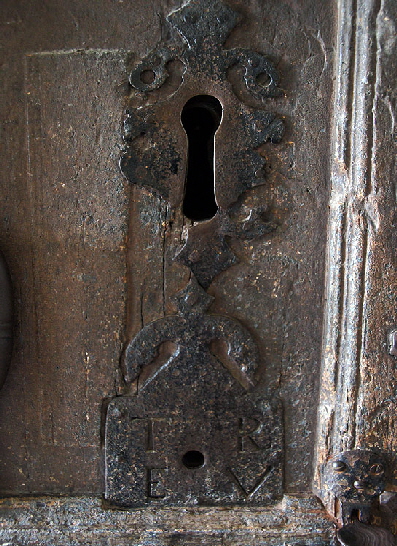 |
|
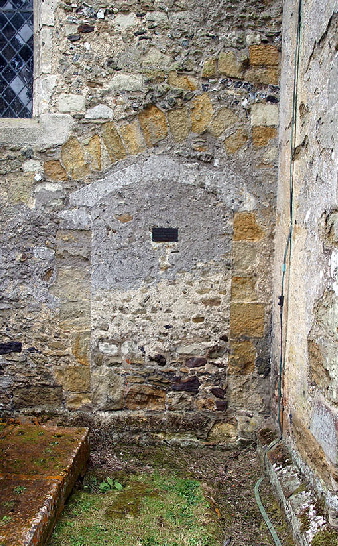 |
|
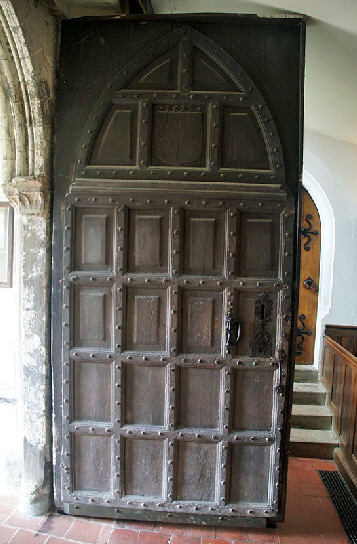 |
|
|
|
|
|
|
Footnote - More about Anchorites
|
|
|
|
There is an excellent synopsis of the anchorite world by Mari Hughes-Edwards accessible by this link. I’m not going to paraphrase it but I will mention some important points.
First of all, let’s address that word “anchorite”. It does not, as you might very reasonably have supposed, derive from the fact that an anchorite was “anchored” to the building: it derives from Greek and means one who has withdrawn from the world.
Secondly, isolation was relative and not absolute. Anchorites did have contact with people on a limited basis and were sometimes consulted for spiritual guidance. Mari says that there are even documented cases of anchorites being temporarily removed from their cells at royal request. An anchorite was a local celebrity, not an object of pity. One might wonder how the poor parish priest coped with this interloper within his domain! Indeed, if anchorites at Compton had access to the upper sanctuary (I am dubious personally) it is separated from the rest of the church only by a wooden rail.
I suppose we are quite familiar with the concept of recluses and hermits. John the Baptist was, perhaps, the most famous. Anchorites, however, had no freedom of movement and were effectively walled up within a building - nearly but not quite always a church - for the rest of their lives. There was no backing out. When Christine Carpenter the anchorite at nearby Shere Church absconded from her immuration she returned on pain of excommunication. To someone sufficiently pious to be an anchorite in the first place, denial of the sacraments would have meant the prospect of eternal damnation and torment. Equally, however, you could not just decide to be an anchorite. Your withdrawal could only be sanctioned by a Bishop who would need to be convinced of your motives, your piety and even that there were the means for you subsistence. Shere Church actually possesses the documents authorising Christine Carpenter’s immuration - and her subsequent return to her cell. There were formalities to be carried out and there were special rites to be observed at the point of immuration.
Anchorites were not necessarily dirt poor in origins. The anchorite at Iffley in Oxfordshire, for example, was of good family. An anchorite might have “servants” to ease her life, although I confess to being ignorant as to precisely what that means.
The concept of withdrawal is a familiar one within the Christian belief system. Withdrawal from earthly comforts and pleasures allows one to “know” God more clearly. The same principle applies to monks and nuns. There was, for example, an inordinate number of monasteries in Lincolnshire and this is explained by the wide availability in mediaeval times of bleak, undrained and inhospitable sites suitable for escaping the joys and temptations of normal life. The life of an anchorite, however, called for a level of self-sacrifice way beyond even the monastic norm..
The majority of anchorites were women and I think this rather explains the fact that most of the literature is written by women! The descendants of Eve, it seems, were regarded as having further to “fall”.
The literature is limited and much of it out of print. I think, though, as with so much pertaining to mediaeval churches it would be a grave mistake to make sweeping generalisations. It seems likely that the conditions under which anchorites lived, their “accommodation”, their degree of isolation and privation and their motives were likely to be many and varied between individuals ands locations. The one thing anchorites surely shared was remarkable piety.
|
|
|
